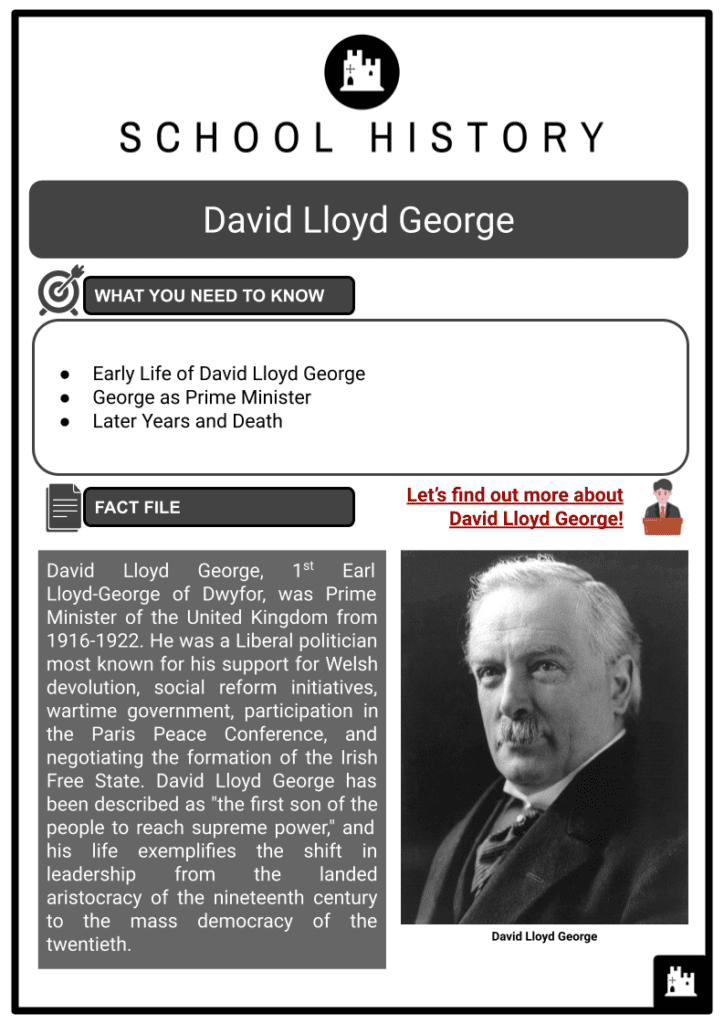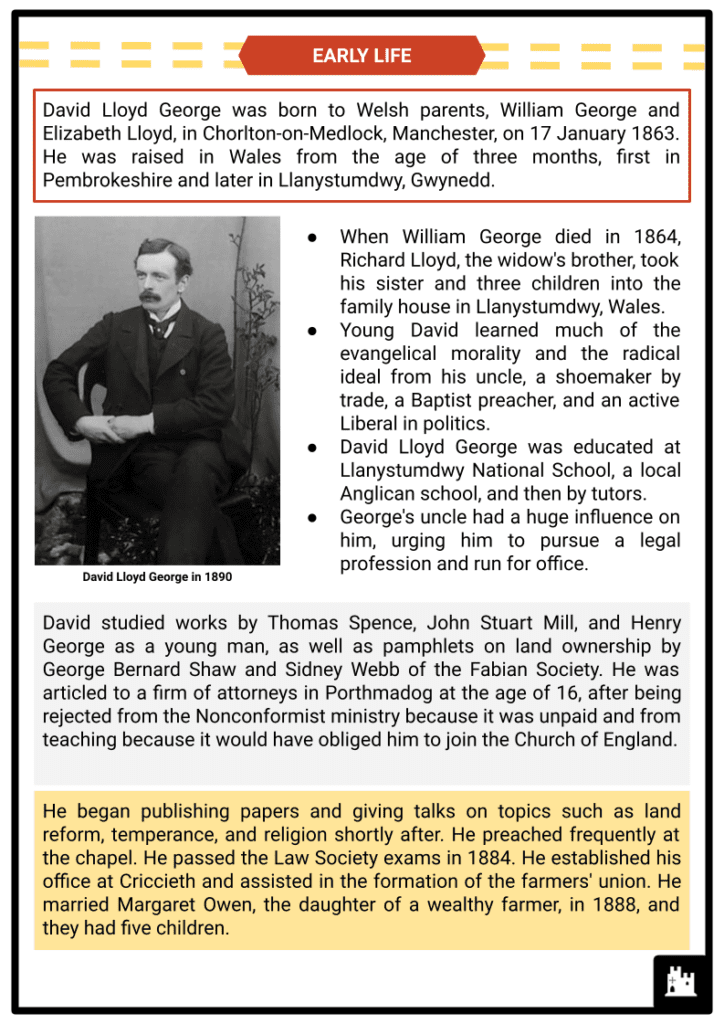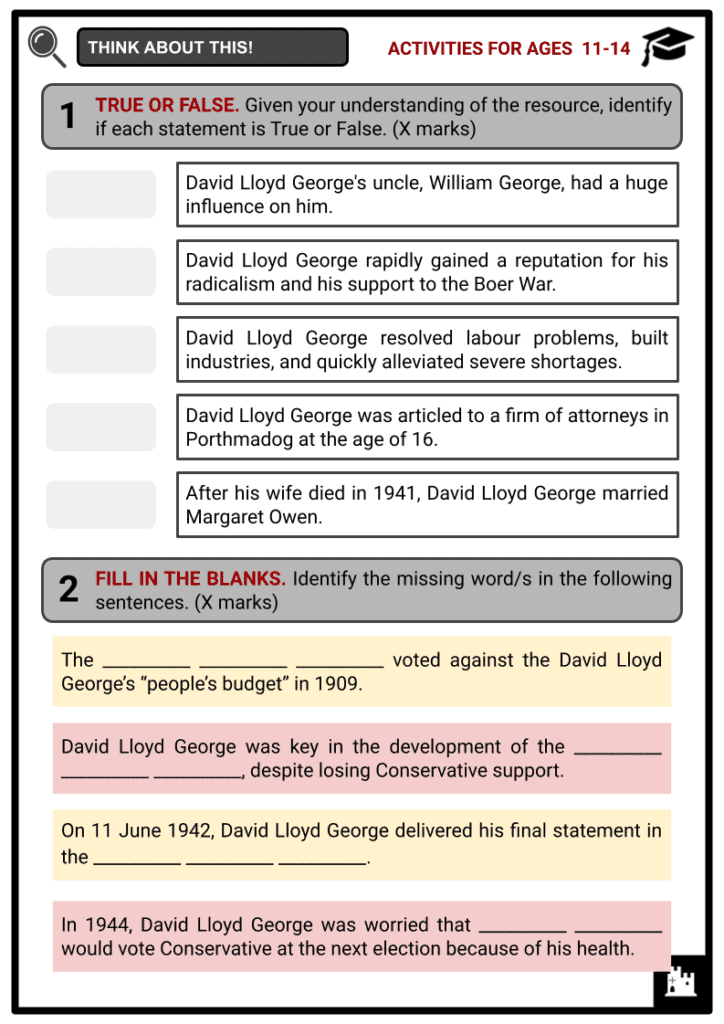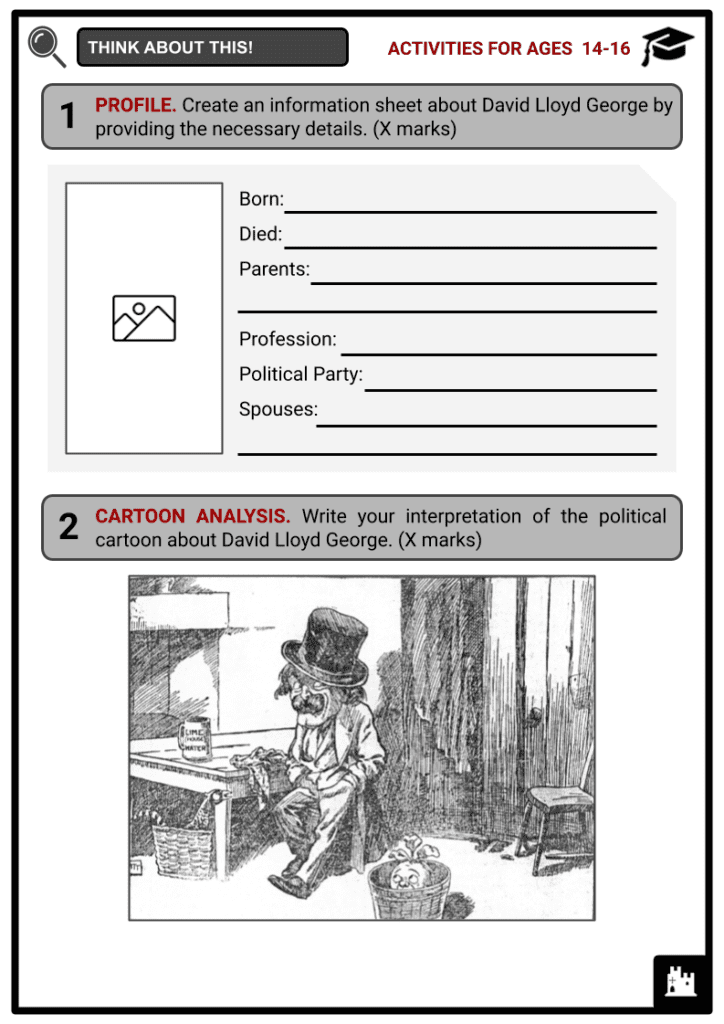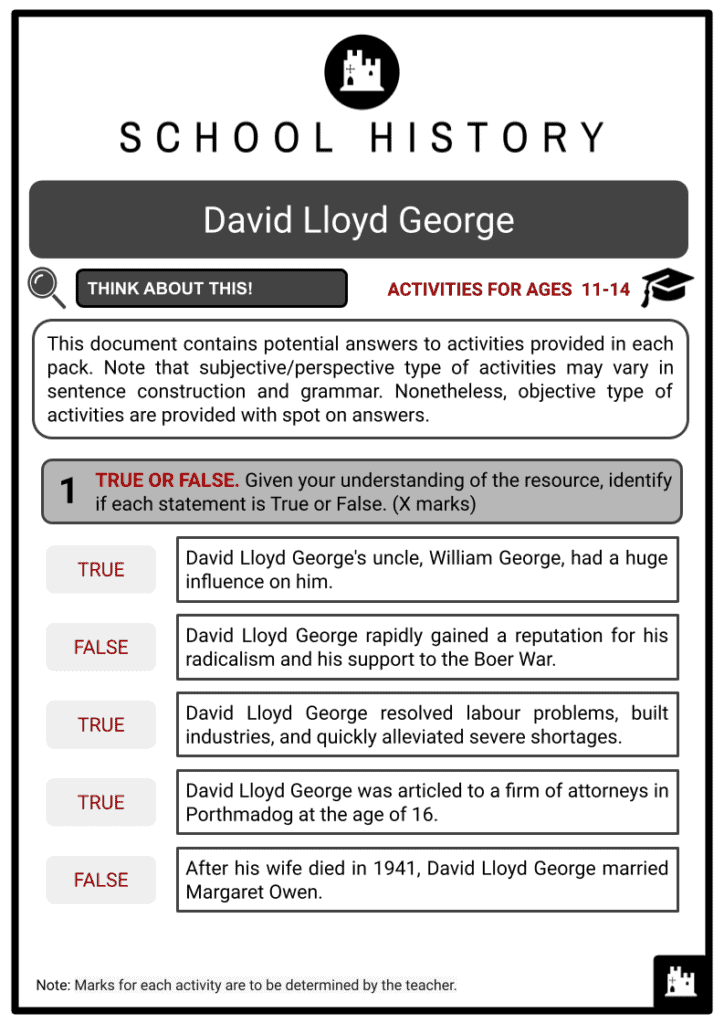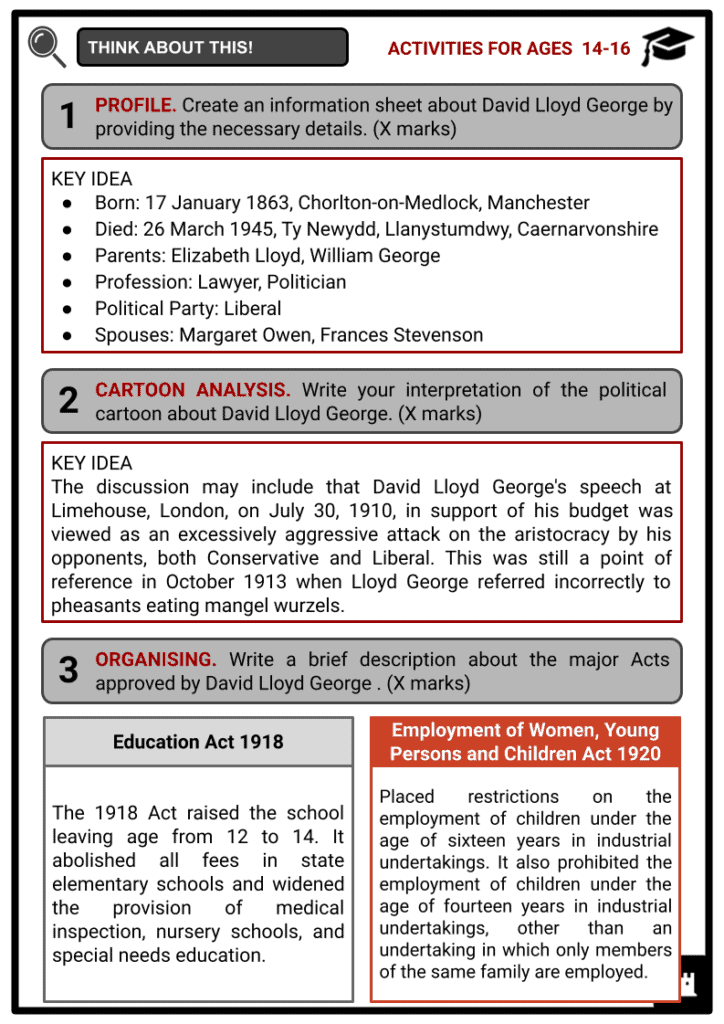Download David Lloyd George
Do you want to save dozens of hours in time? Get your evenings and weekends back? Be able to teach David Lloyd George to your students?
Our worksheet bundle includes a fact file and printable worksheets and student activities. Perfect for both the classroom and homeschooling!
Summary
- Early Life of David Lloyd George
- George as Prime Minister
- Later Years and Death
Key Facts And Information
Let’s find out more about David Lloyd George!
 David Lloyd George, 1st Earl Lloyd-George of Dwyfor, was Prime Minister of the United Kingdom from 1916-1922. He was a Liberal politician most known for his support for Welsh devolution, social reform initiatives, wartime government, participation in the Paris Peace Conference, and negotiating the formation of the Irish Free State. David Lloyd George has been described as "the first son of the people to reach supreme power," and his life exemplifies the shift in leadership from the landed aristocracy of the nineteenth century to the mass democracy of the twentieth.
David Lloyd George, 1st Earl Lloyd-George of Dwyfor, was Prime Minister of the United Kingdom from 1916-1922. He was a Liberal politician most known for his support for Welsh devolution, social reform initiatives, wartime government, participation in the Paris Peace Conference, and negotiating the formation of the Irish Free State. David Lloyd George has been described as "the first son of the people to reach supreme power," and his life exemplifies the shift in leadership from the landed aristocracy of the nineteenth century to the mass democracy of the twentieth.
EARLY LIFE
- David Lloyd George was born to Welsh parents, William George and Elizabeth Lloyd, in Chorlton-on-Medlock, Manchester, on 17 January 1863. He was raised in Wales from the age of three months, first in Pembrokeshire and later in Llanystumdwy, Gwynedd.
- When William George died in 1864, Richard Lloyd, the widow's brother, took his sister and three children into the family house in Llanystumdwy, Wales.
- Young David learned much of the evangelical morality and the radical ideal from his uncle, a shoemaker by trade, a Baptist preacher, and an active Liberal in politics.
- David Lloyd George was educated at Llanystumdwy National School, a local Anglican school, and then by tutors.
- George's uncle had a huge influence on him, urging him to pursue a legal profession and run for office.
- David studied works by Thomas Spence, John Stuart Mill, and Henry George as a young man, as well as pamphlets on land ownership by George Bernard Shaw and Sidney Webb of the Fabian Society. He was articled to a firm of attorneys in Porthmadog at the age of 16, after being rejected from the Nonconformist ministry because it was unpaid and from teaching because it would have obliged him to join the Church of England.
- He began publishing papers and giving talks on topics such as land reform, temperance, and religion shortly after. He preached frequently at the chapel. He passed the Law Society exams in 1884. He established his office at Criccieth and assisted in the formation of the farmers' union. He married Margaret Owen, the daughter of a wealthy farmer, in 1888, and they had five children.
PRIME MINISTER
- David Lloyd George became an attorney and was elected to the Liberal Party's Caernarvon seat in 1890, a position he maintained until 1945. He rapidly gained a reputation for his radicalism and his opposition to the Boer War. Sir Henry Campbell-Bannerman, the prime minister, selected Lloyd George as head of the Board of Trade in 1905.
- In the government of HH Asquith, he was named chancellor of the exchequer in 1908. Lloyd George's 1909 budget has been called the 'people's budget' because it provided for social insurance that was to be partly financed by land and income taxes. The House of Lords voted against the budget. This, in turn, led to the Parliament Act of 1911, which stripped the Lords of their veto authority.
- The Cabinet was split on the war concerns in August 1914. Lloyd George first hesitated, but once Belgium's neutrality was violated, he linked himself against Germany. In the newly constituted Ministry of Munitions, to which he was appointed in Asquith's coalition government in May 1915, his reputation rose.
- David Lloyd George resolved labour problems, built industries, and quickly alleviate severe shortages by producing more than was required. Lloyd George became Minister of War when Lord Kitchener was drowned at sea in June 1916. "The fight must be to the finish—to a knockout blow, " he declared. However, Asquith's aimless leadership did not appear to be headed in this direction.
- In December 1916 Asquith, faced by a revolt from Conservatives along with Lloyd George, decided to resign. Lloyd George was successful. The "Welsh Wizard" was the lone Liberal in the new War Cabinet of five, yet he "towered like a giant." His position is controversial, but he galvanised the war effort, and it is widely agreed that England would not have emerged from the fight as effectively without him.
- Despite Asquith's and his Liberal supporters' defections, Lloyd George, with significant Conservative support, opted to keep the coalition going towards the end of the war. In the 1918 election, he received a landslide victory. At the peace conference he facilitated effectively between the idealism of U.S. president Woodrow Wilson and the punishing terms sought by French premier Georges Clemenceau.

- In 1921, he was key in the development of the Irish Free State, despite losing Conservative support in the process.
- However, Lloyd George's oratory about building "a new society" at home was in vain; he lacked Conservative support for change, and his own attempts were ambiguous.
- The Turkish crisis of 1922 shattered Conservative disenchantment—he was pro-Greek, while the Conservatives were pro-Turk.
- The Conservatives in the House of Commons voted by a margin of more than 2 to 1 to break the ties.
- Lloyd George was 59 years old at the time, but his ministerial career had come to an end. He never re-established himself in the Liberal Party, which had been irreparably divided between his followers and those of Asquith, and had suffered leadership and rank-and-file defections to Labour.
- In 1929, Lloyd George sought a personal comeback by advocating for significant government intervention in the economy. His popular vote (25%) was good, but the Liberals remained a distant third in the Commons.
- His authority in the Commons was limited to his family party of four when he renounced party leadership.
FINAL YEARS AND DEATH
- In the 1930s, Lloyd George had just a little effect. He was listened to but hardly followed in many areas because he was distrusted. He slammed the Hoare-Laval Abyssinian agreement. But, despite his reservations about Versailles, he admired Hitler's Germany and paid a visit to the Führer in Berchtesgaden in 1936. As the crisis worsened, Lloyd George pressed for a clear indication of the British government's objectives. In May 1939, in his final major speech in the Commons, he urged for Neville Chamberlain's resignation, which he received and replaced with Winston Churchill.
- After Hitler's seizure of Poland in October 1939, Lloyd George recommended serious consideration of Hitler's peace appeals. While preparing for an invasion of England in July 1940, Hitler made more overtures to the British people, toying with the notion of reinstating the Duke of Windsor to the monarchy and Lloyd George to 10 Downing Street.
- Churchill compared Lloyd George to Philippe Pétain when he gave a pessimistic speech on May 7, 1941.
- On 11 June 1942, he delivered his final statement in the House of Commons, and on 18 February 1943, he was one of 121 MPs (97 Labour) who condemned the government for failing to support the Beveridge Report.
- His final vote was in defence of the welfare state, which he had helped to establish.
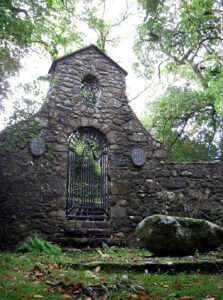
- He continued to attend London's Castle Street Baptist Chapel, but by 1944, he was rapidly deteriorating and his voice was failing.
- He was still an MP, but he was worried that Carnarvon Boroughs would vote Conservative at the next election because of his health (he felt physically unable to campaign) and the wartime social changes in the constituency.
- He accepted a peerage since he want to have an official platform to speak on any peace settlement as the only living author of the Versailles settlement. It was announced in the 1945 New Year Honours that Lloyd George would be made an earl, which he was as Earl Lloyd-George of Dwyfor, and Viscount Gwynedd, of Dwyfor in the County of Caernarvonshire on 12 February 1945; however, he did not live long enough to take his seat in the House of Lords.
- Lloyd George spent much of his later years at his house in Churt, Surrey. After his wife died in 1941, he married Frances Louise Stevenson, his personal secretary for 30 years, two years later. They left Churt in 1944 to settle in Wales, close to his boyhood home. He was raised to the peerage on Dec. 31, 1944. On March 26, 1945, he passed away. On March 26, 1945, at the age of 82, Lloyd George died of cancer, surrounded by his wife Frances and daughter Megan. He was buried alongside the river Dwyfor in Llanystumdwy four days later, on Good Friday.

